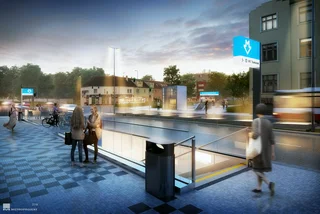The Českomoravská station on Prague’s Metro B line will get a new look. Maxim Velčovský and edit! architects won a competition for the redesign, beating 42 other teams. The original ceramic tiles will be replaced by glass plates, building on the metro line’s artistic tradition.
The Prague Public Transit Company (DPP) at the end of this year will announce another competition to find a contractor for the station’s renovation. DPP expects to start its work in the second half of 2024, the DPP said in a press release.

Designers were asked to create a new interior of the station, including glass wall coverings behind the track and in the entrance vestibule, and to choose the color of the enamel wall coverings on the platform and in the escalator tunnel.
Putting the station in context
Deputy Mayor Zdeněk Hřib, responsible for transport and chairman of the DPP supervisory board, said metro stations are an inseparable part of Praguer’s everyday life and should not only be functional but also a pleasant place. The winning design with textured glass fulfills this.
“The aesthetically ‘brushed’ Českomoravská metro station will become an inseparable part of the transformation of the entire area around the station into a multifunctional and diverse part of the city,” Hřib said.
The area near the station is now home to O2 Arena, O2 universum, the Harfa shopping center, and new hotels and housing.
Conference Producer

Easy manual work with electronics - start 8th Jan

The use of glass and enamel was chosen for ease of maintenance as well as the artistic tradition of the Prague metro. Glass already appears as an artistic element in several stations along the metro B route. The station’s original ceramic design has proved to be unsuitable over time, as it is susceptible to damage from water.

The winning team of designer Maxim Velčovský and architect Vítězslav Danda from edit! architects was selected from nine finalists. The winner received an award of CZK 150,000.
Traffic, travel, and movement are reflected in the winning design through a glass grid.
"We approached the redesign of Českomoravská in the context of new changes to the entire area and the context of the entire B line, where individual stations unify certain approaches, pillar shapes, structures, and grids. So we tried to be an evolution rather than a revolution," Velčovský, designer and artistic director of the company Lasvit, said.

“The grid is caused by the connection and construction of two glass surfaces, between which bubbles remain trapped. Each glass, therefore, creates a unique grid, but at the same time, it is possible to easily replicate it. The glass grid better absorbs potential optical damage and scratches,” he said.
An imaginative yet conservative approach
The jury called the winning solution imaginative, minimalistic, humble, and feasible. They appreciated the proposal as visually clean with a focus on the material and an emphasis on formality.
DPP project manager a jury member Anna Švarc said the conservative proposal is essentially evolutionary by leaps and bounds.
“The project continues the tradition of using original glass in the Prague metro, quoting almost verbatim the format of the cladding of the existing station, but also presents new technological possibilities for working with the material, anchoring it or combining it with enamel, which is typical for adjacent stations,” she said.

Czech artist Vladimír Brož, better known as Vladimir 518, sat on the competition jury as a member with advisory rights. He noted that the specific geology of the station, which includes harsh groundwater, made the design a difficult task.
“Although in other situations we would probably support a bolder artistic and technological solution, or plead for a precise restoration to the original state, in the given situation the winning proposal is an optimal compromise between the history of the place, its context, and a new approach to the matter," he said.












 Reading time: 3 minutes
Reading time: 3 minutes 



 Swedish
Swedish
 Finnish
Finnish
 Danish
Danish
 Polish
Polish
 German
German
























